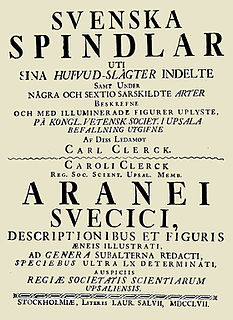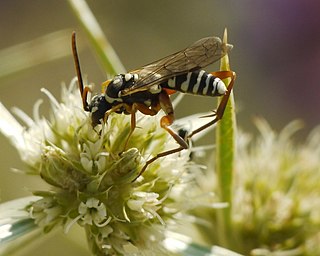
In taxonomy, binomial nomenclature, also called binominal nomenclature or binary nomenclature, is a formal system of naming species of living things by giving each a name composed of two parts, both of which use Latin grammatical forms, although they can be based on words from other languages. Such a name is called a binomial name, a binomen, binominal name or a scientific name; more informally it is also called a Latin name.
The International Code of Zoological Nomenclature (ICZN) is a widely accepted convention in zoology that rules the formal scientific naming of organisms treated as animals. It is also informally known as the ICZN Code, for its publisher, the International Commission on Zoological Nomenclature. The rules principally regulate:

A holotype is a single physical example of an organism, known to have been used when the species was formally described. It is either the single such physical example or one of several such, but explicitly designated as the holotype. Under the International Code of Zoological Nomenclature (ICZN), a holotype is one of several kinds of name-bearing types. In the International Code of Nomenclature for algae, fungi, and plants (ICN) and ICZN, the definitions of types are similar in intent but not identical in terminology or underlying concept.

Wasps in the family Pompilidae are commonly called spider wasps, spider-hunting wasps, or pompilid wasps. The family is cosmopolitan, with some 5,000 species in six subfamilies. Nearly all species are solitary, and most capture and paralyze prey, though members of the subfamily Ceropalinae are kleptoparasites of other pompilids, or ectoparasitoids of living spiders.

Mud dauber is a name commonly applied to a number of wasps from either the family Sphecidae or Crabronidae that build their nests from mud; this excludes members of the family Vespidae, which are instead referred to as "potter wasps". Mud daubers belong to different families and are variable in appearance. Most are long, slender wasps about 1 inch (25 mm) in length. The name refers to the nests that are made by the female wasps, which consist of mud molded into place by the wasp's mandibles. Mud daubers are not normally aggressive, but can become belligerent when threatened. Stings are uncommon.

Caladenia, commonly known as spider orchids, is a genus of 350 species of plants in the orchid family, Orchidaceae. Spider orchids are terrestrial herbs with a single hairy leaf and a hairy stem. The labellum is fringed or toothed in most species and there are small projections called calli on the labellum. The flowers have adaptations to attract particular species of insects for pollination. The genus is divided into three groups on the basis of flower shape, broadly, spider orchids, zebra orchids and cowslip orchids, although other common names are often used. Although they occur in other countries, most are Australian and 136 species occur in Western Australia, making it the most species-rich orchid genus in that state.
In biology, a homonym is a name for a taxon that is identical in spelling to another such name, that belongs to a different taxon.
In biological nomenclature, a nomen novum, new replacement name is a scientific name that is created specifically to replace another scientific name, but only when this other name cannot be used for technical, nomenclatural reasons. It does not apply when a name is changed for taxonomic reasons. It is frequently abbreviated, e.g.nomen nov., nom. nov..

Coneweb spiders (Diguetidae) are six-eyed haplogyne spiders that live in tangled space webs, fashioning a cone-like central retreat where they hide and lay eggs. It is a small family, containing only two genera with fifteen species and is confined to the New World, preferring deserts. Members of the genus Diguetia usually build their webs in shrubs or between cactus pads. They have the same eye arrangement as the venomous recluse spiders, but none are known to be harmful to humans.

A wasp is any insect of the narrow-waisted suborder Apocrita of the order Hymenoptera which is neither a bee nor an ant; this excludes the broad-waisted sawflies (Symphyta), which look somewhat like wasps but are in a separate suborder. The wasps do not constitute a clade, a complete natural group with a single ancestor, as their common ancestor is shared by bees and ants. Many wasps, those in the clade Aculeata, can sting their insect prey.

The book Svenska Spindlar or Aranei Svecici was one of the major works of the Swedish arachnologist and entomologist Carl Alexander Clerck and appeared in Stockholm in the year 1757. It was the first comprehensive book on the spiders of Sweden and one of the first regional monographs of a group of animals worldwide. The full title of the work was Svenska Spindlar uti sina hufvud-slägter indelte samt under några och sextio särskildte arter beskrefne och med illuminerade figurer uplyste – Aranei Svecici, descriptionibus et figuris æneis illustrati, ad genera subalterna redacti, speciebus ultra LX determinati, and included 162 pages of text and 6 colour plates. It was published in Swedish, with a Latin translation printed in a slightly smaller font below the Swedish text.

Anoplius is a genus of spider wasps in the family Pompilidae, called the blue-black spider wasps.

The Ceropalinae are a subfamily of the Pompilidae, the spider wasps, containing two genera, whose members are kleptoparasitic on other solitary wasps which hunt spiders, mainly fellow members of the Pompilidae.

Caliadurgus is a genus of spider wasps of the subfamily Pepsinae. These are medium-sized black spider wasps with some red. They have a catholic habitat choice and their preferred prey are spiders of the families Araneidae and Tetragnathidae. They have a Holarctic and Neotropical distribution.

Cantuaria dendyi is a species of trapdoor spider in the family Idiopidae. It can be found in the South Island of New Zealand and is limited to the Christchurch and Banks Peninsula area.

Pepsis grossa is a very large species of pepsine spider wasp from the southern part of North America, south to northern South America. It preys on tarantula spiders, giving rise to the name tarantula hawk for the wasps in the genus Pepsis and the related Hemipepsis. Only the females hunt, so only they are capable of delivering a sting, which is considered the second most painful of any insect sting; scoring 4.0 on the Schmidt sting pain index compared to the bullet ant's 4.0+. It is the state insect of New Mexico. The colour morphs are the xanthic orange-winged form and the melanic black winged form. In northern South America, a third form, known as "lygamorphic", has a dark base to the wings which have dark amber median patches and a pale tip.

Scelioninae is a subfamily of wasps in the family Platygastridae. It is a very large cosmopolitan group of exclusively parasitoid wasps, mostly small (0.5–10 mm), often black, often highly sculptured, usually with geniculate (elbowed) antennae that have a 9- or 10-segmented flagellum. It was formerly considered to be a family Scelionidae but has been reclassified as a subfamily of the Platygastridae.













